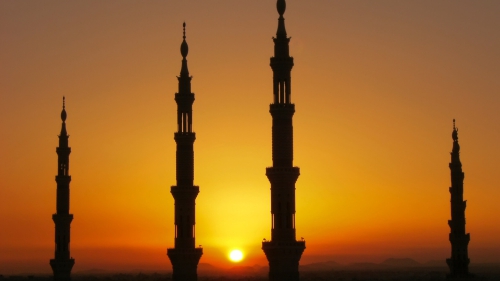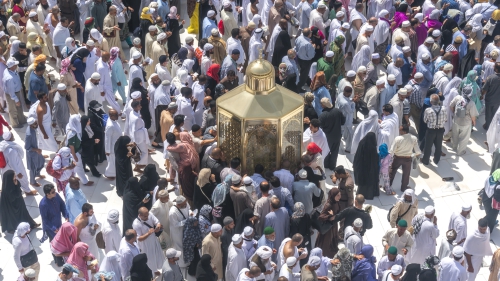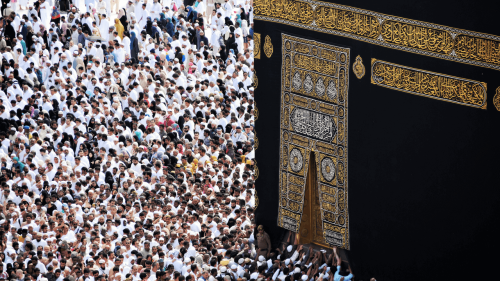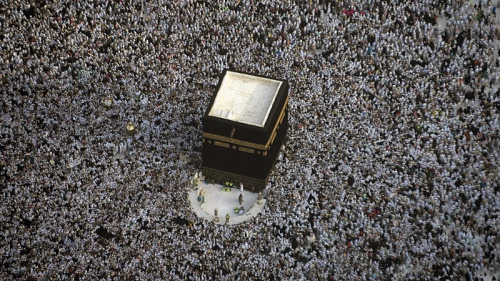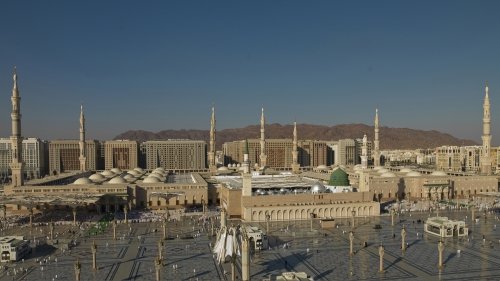Religious Pilgrimage Promotes Human Progress

The majestic mountains of northern India, Nepal, and Tibet have long been viewed as the home of many of India’ gods. In India itself there are dozens of pilgrimage sites, especially the Ganges river which hosts many millions of pilgrims each year at different locations on the Ganges.
Although not mentioned in the Vedas or the Upanishads, Mount Meru was already legendary before the great Hindu epics, the Ramayana and the Mahabharata, and the classical texts of Hinduism, Jainism, Bon or Buddhism were written. The cosmologies and origin myths of each of these four polytheistic religions speak of the mythical Mount Meru, the center and birthplace of the entire world.
A recent genetic study by Svante Pääbo, a major pioneer in ancient genetics at Germany's Max Planck Institute for Evolutionary Anthropology, found that compared to Homo Neanderthals, our species (Homo Sapiens) had much greater genetic variety, something consistent with hardiness, fortitude, and resilience.
Homo Neanderthal genes suggested that sometime prior to 500,000 years ago, Neanderthal numbers decreased and the population stayed small, Pääbo's group determined. Pääbo states: "Genetic diversity among Neanderthals was about one-fourth as much as is seen among modern Africans, and one-third that of modern Europeans or Asians.”
Why did ancient Homo Sapiens have a much larger population size than did the Homo Neanderthals? Until recently the standard explanation was that our species was smarter or more technologically advanced than ‘them.‘ But a published study proves that there is little real evidence for that species-chauvinistic view. (see Neanderthal Demise: An Archaeological Analysis of the Modern Human Superiority Complex by Paola Villa and Wil Roebroeks Published: PLOS ONE April 30, 2014, DOI: 10.1371/journal.pone. 0096424 )
Over the long run, shared religious rituals have increased group stability; and even more important, religious pilgrimages have enabled growing groups of tribes to remain in contact even long after they had moved far apart geographically.
There is social bonding and solidarity reflected by the first archetypical set of directions given to Homo Sapiens: "God created Adam in His own image, created in the image of God; male and female created He them. God blessed them; and God said to them: 'Be fruitful, and multiply, and fill the earth...'" (Genesis 1:27-28).
As Adam's descendants multiplied and migrated, the specific traditions of pilgrimage to non-local sacred spots were founded in the early days of today's religions, especially in Islam and Judaism: In Islamic tradition, the holy site of the Kâ'bah was consecrated in the pre-historic days of Adam. The site of Prophet Solomon’s Temple was consecrated 40 years later, which was thousands of years before David would locate and acquire the site where his son Solomon would build the Jerusalem temple.
Abu Dharr narrated: I said, "O Allah's Apostle! Which mosque was first built on the surface of the earth?" He said, "Al-Masjid-al-Haram (in Mecca)." I said, "Which was built next?" He replied "The mosque of Al-Aqsa (in Jerusalem)." I said, "What was the period between the two?" He said, "Forty years.” (Sahih al-Bukhari: Volume 4, Book 55, Hadith 585)
Such pilgrimage sites were established, or consecrated, as collective places of worship for groups larger than the family, band, clan, or tribe.
I use the English word 'consecrate' in regard to the site because the sense of 'built' isn't found in the original Arabic hadith. 'Built' is a mistranslation of the word وُضِعَ: which has several meanings, such as stationed, situated or positioned, referring to a location, not to construction.
Thus, وُضِعَ doesn't mean "built." In fact, the present-day Kâ'bah is not a building constructed by Adam. That is not the point of Abu Dharr's hadith! Rather, the Kâ'bah is located on the geographical site where Adam first consecrated a place of worship/prayer to the One God. Similarly, the site of Solomon's Temple (in Jerusalem) was consecrated as a holy site long before Solomon was even born.
Hajj (Pilgrimage) is a religious ritual practiced among the people of a cohesive religious community like Jews and Muslims. Pilgrimage to a shared sacred spot is an important factor in social cohesion, and social cohesion is an important factor in coping with challenges to survival. Both Islam and Judaism have texts which date our ancestry back to Adam, and the origins of modern humankind.
The following traditional tale, transmitted orally in both Arabic and Hebrew for many centuries and finally written down in several different versions in the 19th century, illustrates how two holy places like the Ka’bah and the Jerusalem Temple can be closely connected even though they are geographically separated by 765 miles. Some say this happened in the age of Adam or Noah, and others say only long before Prophet Abraham was born:
Two brothers who inherited a ‘valley to hilltop’ farm from their father divided the land in half so that each one could farm his own section. Over time, the older brother married and had four children, while the younger brother was still not married. One year there was very little rain, and the crop was very meager. This was at the beginning of a long-term drought that would turn the whole valley into an arid, treeless, desert where even grain did not grow, and all the springs dried up.
The younger brother lay awake one night praying and thought: "My brother has a wife and four children to feed, and I have no children. He needs more grain than I do, especially now when the grain is scarce.” So that night, the younger brother went to his barn, gathered a large sack of wheat, and left his wheat in his brother's barn. Then he returned home.
Earlier that very same night, the older brother was also lying awake praying for rain when he thought: "In my old age, my wife and I will have our grown children to take care of us, as well as grandchildren to enjoy, while my brother may have no children. He should at least sell more grain from his fields now, so he can provide for himself in his old age. So that night, the older brother also gathered a large sack of wheat, and left it in his brother's barn, and returned home.
The next morning, the younger brother, surprised to see that the amount of grain in his barn seemed unchanged, said "I did not take as much wheat as I thought. Tonight I'll take more." That same morning, the older brother, standing in his barn, was thinking the same thoughts.
After night fell, each brother gathered a greater amount of wheat from his barn and in the dark, secretly delivered it to his brother's barn. The next morning, the brothers were again puzzled and perplexed. "How can I be mistaken?" each one thought. "There's the same amount of grain here as there was before. This is impossible! Tonight I'll make no mistake—I'll take two large sacks.”
The third night, more determined than ever, each brother gathered two large sacks of wheat from his barn, loaded them onto a cart, and slowly pulled his cart toward his brother's barn. In the moonlight, each brother noticed a figure in the distance.
When the two brothers got closer, each recognized the form of the other and the load he was pulling, and they both realized what had happened! Without a word, they dropped the ropes of their carts, ran to each other, and embraced.
Only God can make anything holy, so perhaps God thought the brothers’ love and concern for each other was a wonderful example for future generations and made their descendants worthy to rebuild a primordial Holy House in this valley, and 40 years later to build a new Holy House on that hill. So God sent Messengers to their descendants to guide them to do this.
When all those, both near and far, who revere these sacred places as a standard, share it in love with everyone else who reveres it, then Abraham’s request for Allah to “Make this a land of peace, and provide its people with the produce of the land” [Surat Al- Baqarah, 2:126] will be extended throughout the world; and all the children of Adam, Noah, and Abraham will live in Holiness, Peace, and Prosperity.
Christians and Jews believe the hill is Jerusalem. Muslims believe the valley is Mecca. I believe they are both right and God willing, someday everyone may see both cities and their sanctuaries as a pair of lungs; that is central to humanity’s spiritual inspiration by, and connection to, the One God of Abraham, Ishmael, and Isaac. As the Qur’an states: “'Believers, be steadfast in the cause of God and bear witness with justice. Do not let your enmity for others turn you away from justice. Deal justly; that is nearer to being God-fearing.” (5:8)
If we can all live up to the ideal of brotherhood that the above narration teaches; that religious pluralism is the will of God, we will help fulfill the 2700-year-old vision of Prophet Isaiah: “On that day there will be a highway from Egypt to Assyria. The Assyrians will go to Egypt and the Egyptians to Assyria. The Egyptians and Assyrians will worship together. On that day Israel will join a three-party alliance with Egypt and Assyria, a blessing upon the heart. The LORD of Hosts will bless them saying, “Blessed be Egypt My people, Assyria My handiwork, and Israel My inheritance.”…(Isaiah 19:23-5)
Allen S. Maller is an ordained Reform Rabbi who retired in 2006 after 39 years as the Rabbi of Temple Akiba in Culver City, California. His website is www.rabbimaller.com. He blogs on the Times of Israel. Rabbi Maller has published 450+ articles in some two dozen different Christian, Jewish, and Muslim magazines and websites. He is the author of two recent books: "Judaism and Islam as Synergistic Monotheisms' and "Which Religion Is Right For You? A 21st Century Kuzari".









